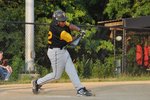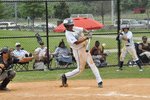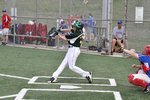 Severna Park
Severna ParkFair, 47°
Wind: 0.0 mph, N
 Severna Park
Severna Park







Text and photos by Colin Murphy. Graphics by Will Nauman.
Hitting a baseball is regarded by many as the single most difficult skill in sports. As Hall of Famer and career .344 hitter Ted Williams famously said, “Baseball is the only field of endeavor where a man can succeed three times out of ten and be considered a good performer.” The probability of failure in hitting is so great, the margin for error so slim, even the best hitters have the odds stacked squarely against them. A batter must contend with a multitude of hard-to-predict factors when attempting to hit: the speed of the pitch, the location of the pitch, the movement of the pitch. If the batter decides to swing, he must do so with the right combination of timing, balance, precision, and hand-eye coordination in order to make contact with the ball. If he is fortunate enough to make contact, he must hit the ball in a confined space and put it where the fielders aren’t. Not easy.
So what does it take to hit a baseball? The broad answer is countless hours of practice, a youth spent honing the skill. The specific answer lies in the mechanics. To break down the anatomy of an effective baseball swing, we asked area coaches and players—as well as one of baseball’s leading scientists—for their thoughts on what goes into hitting a baseball effectively. Featuring photos of many of the area’s top young players, here’s a step-by-step, in-depth look at the most difficult skill in sports.
The Stance – the stance is about establishing balance and position at the plate. The batter should have his feet a little bit more than shoulder-width apart, with a relaxed, athletic bend in the knees. Stances vary widely from player to player, but they maintain this core element.
The “Load” or “Trigger” – as the pitch is coming out of the pitcher’s hand, or slightly before, the player’s hands go back and up, which “loads” the batter’s power in preparation for swinging. It is important for the batter to keep his weight and hands back as the pitch is oncoming, and to keep his head totally still. The batter should take a short, quick stride of no more than six inches with his front foot, widening his stance. This is sometimes referred to as the “trigger stride.”
Initiating the Swing – As the batter begins to swing, the first movement is in the hips. “The hips open up first, before the hands begin to move,” says Dr. Alan Nathan, a professor of physics at the University of Illinois who has authored and conducted numerous research studies on the physics of baseball. “This generates rotational motion that then gets transferred up the body, to the arms and to the bat.”
As the hands begin to swing, they stay close to the body, which creates a short swing. A big, looping swing sacrifices power and bat speed because the hands have to travel a longer path to the anticipated point of contact. A short swing wastes no motion. Some coaches teach players to “throw the butt of the bat at the ball,” which forces a short, compact swing.
Point of Contact –The collision between bat and ball is both powerful and lightning-fast. “The ball-bat contact time is very small, about 1/1000 of a second,” says Nathan. “During that time, there are very large forces that the ball exerts on the bat, up to 8000 pounds or more.” For the batter making contact with the ball, his back thigh should be perpendicular to the ground, forming a right triangle with the ground and the batter’s front leg. The front knee remains locked; a bent front leg allows power to dissipate. The bat head should be as close to level with the ground as possible, depending on the location of the pitch. Keeping the weight back is also essential in generating power; leaning forward allows the front knee to unlock and makes for a weak swing.
Following through – As the old hitting adage goes, a batter should be “short to it, long through it.” After the short, quick swing creates contact, the batter should follow through by extending the arms and fully completing the swing. As a batter is awaiting a pitch, his chin is resting on his front shoulder; after the swing, the chin should come to rest on the back shoulder—this creates a full follow-through on the swing.
Overall Philosophy – A swing that is fundamentally sounds mechanically is important to hitting success, but most important is what the batter can’t control: getting the right pitch. Generally batters look for a fastball on the middle or inner portion of the plate. But a batter may only get one hittable pitch in any given at-bat, or even in an entire game, so he must always be predicting and anticipating the pitcher’s intentions. Patience and discipline are likewise essential; a batter must be patient enough to take a walk and disciplined enough to refrain from swinging at pitches outside of the hitting zone.
Think a different skill or element of sports is more difficult than hitting a baseball? Disagree with our analysis of the swing? Tell us about it! Email your thoughts to colin@severnaparkvoice.com or post a comment below.
Special thanks to Green Hornets coaches Dave Ferris, Andrew Anawalt, Mark Burkowski, and Steve Meany; Northeast High JV Coach Tom Caines; and Prof. Alan Nathan for contributing their insights on hitting to this article.
Comments
No comments on this item Please log in to comment by clicking here